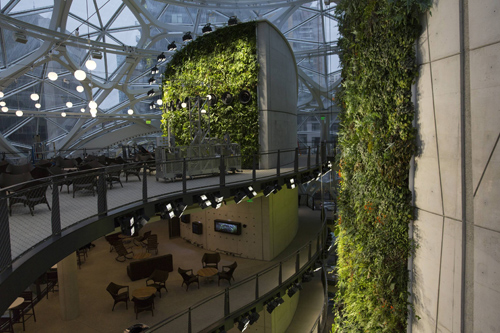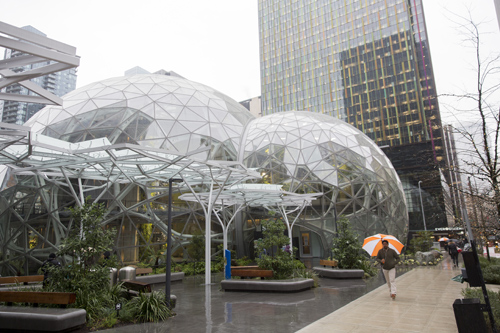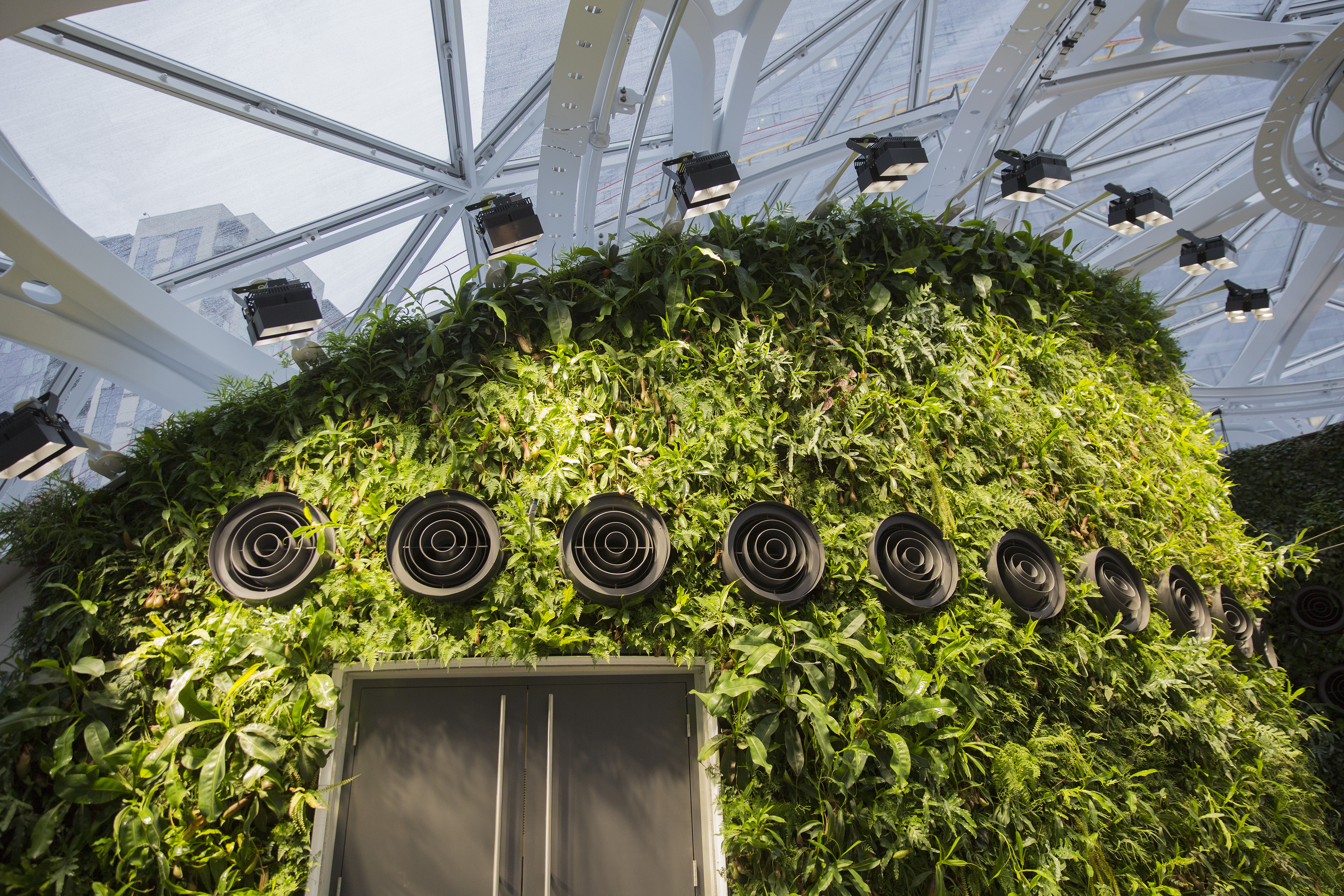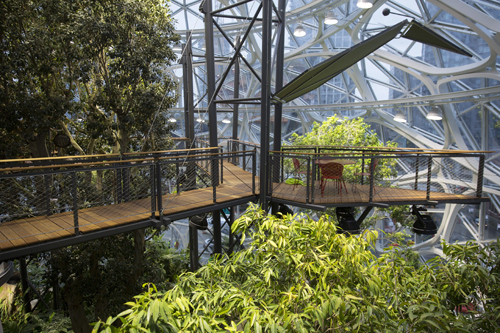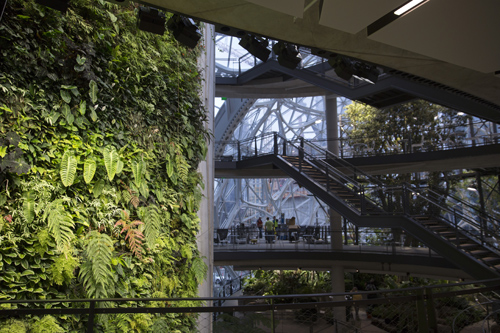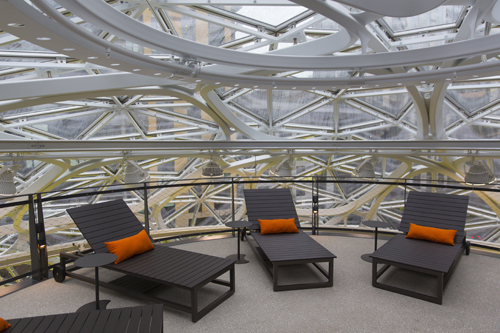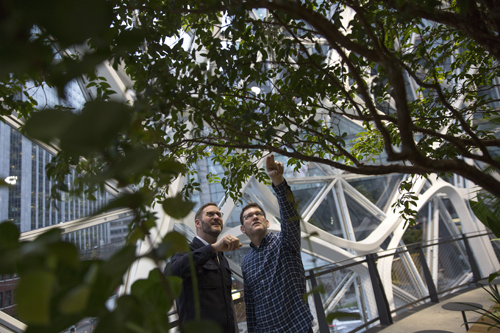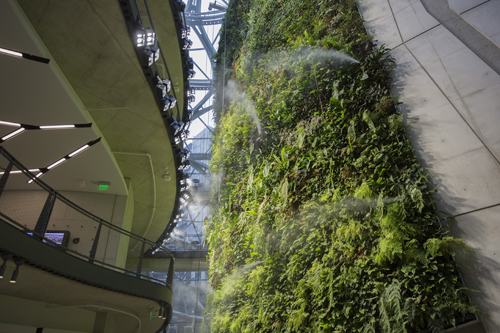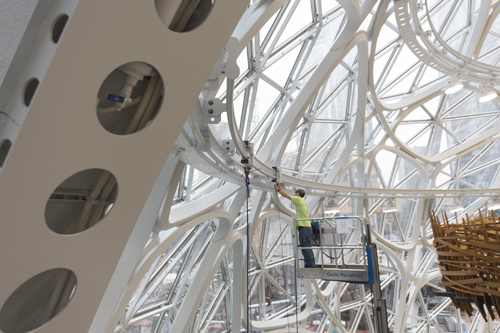收購這家超市后,,亞馬遜正在努力成為零售業(yè)霸主
|
2017年6月16日早上9點,,全食超市(Whole Foods)的員工紛紛擠入位于奧斯汀的公司總部大樓主層。就在一小時前,,亞馬遜(Amazon)宣布收購這一高端純天然食品供應商,,全食員工和公眾對此都是瞠目結舌。在兩家公司商談收購的七周時間里,,亞馬遜積極阻止任何小道消息的泄露,,而全食公司的大多數(shù)員工對即將達成的交易則渾然不知。 現(xiàn)在全食的員工將第一次見到他們的新主人,。全食超市CEO約翰·麥基向大伙介紹了亞馬遜的杰夫·威爾克,,他是電商巨頭亞馬遜的全球消費者業(yè)務CEO,如今他已把目光對準了食品消費客戶群。 “我想先說一說,,全食超市如何改變了我的生活,。我早上起來吃早餐,看著太陽升起在這美麗的城市——我的餐盤里有藜麥,、藍莓和其他一些蔬菜······” 這時候,,素食主義的麥基(他不吃精加工食品,旅行都帶著電飯鍋)笑語輕盈地糾正了威爾克,,“這些不全是蔬菜,。”威爾克回答:“沒事兒,,我們正在學習,。” 那一刻清晰地折射出為什么威爾克和他的團隊如此需要全食超市,。一句口誤只是偶然,,但卻反映了亞馬遜一直以來的一個困擾——在許多領域富有經(jīng)驗,但在食品行業(yè)不行,。十年來,,亞馬遜公司——這個年銷售額達到1780億美元,且看似擁有無限資源的公司——從未在鮮食領域有過接近10億美元的銷售額,。 食品領域表現(xiàn)乏力并不全是這個零售巨頭自身的原因,。生鮮食品業(yè)的生意難做是出了名的——不用說還有各種成本和物流的挑戰(zhàn)。紐約大學斯特恩商學院的市場營銷學教授斯科特·加洛維將這一問題總結為:一顆生菜的利潤不到1美元,,如不冷藏,,保質期不超過一天,零售商要將新鮮的生菜交到顧客手里,,還要贏取利潤,,如何做得到? 這筆137億美元的收購給亞馬遜打了興奮劑,,有望重塑價值8000億美元的美國生鮮食品業(yè),,這是電子商務最后的、也是份額極重的待開墾領域,。大約20%的零售業(yè)支出用于購買食物,,但這一支出中只有2%是通過網(wǎng)購的。線上生鮮食品店Peapod首席市場官嘉麗·比恩考斯基認為,,“生鮮食品業(yè)是電商的荒野西部,,這塊蛋糕巨大,還在增長,?!? 生鮮食品的遞送困難——因為它會變質——而這恰恰是亞馬遜非得要進入這個行業(yè)的原因,。奶酪會發(fā)霉,肉會發(fā)臭,,牛奶會變酸,,所以不同于手紙或者洗潔精,消費者不能在櫥柜或冰箱里長時間貯存這些鮮食,。因此,,每個家庭大概一周至少得去一趟超市采購新鮮食品,而沒有任何其他商品會讓人們消費如此之多,,如此之頻繁,。對于亞馬遜來說,進入鮮食行業(yè)是讓人們的日常生活和消費習慣離不開亞馬遜的關鍵環(huán)節(jié),。在全食超市的前聯(lián)合CEO沃爾特·羅伯看來,,“賣食品是賣其他一切的基礎,是真正意義上的日常生活,,沒有任何其他品類可與之相提并論,。”由此看來,,亞馬遜的這筆收購可不只是進入食品行業(yè)這么簡單,。 在零售業(yè),亞馬遜或許是最會挑事,,也最富創(chuàng)新的公司,,不過用食品作杠桿來帶動銷售并不是新鮮事。沃爾瑪(Walmart)轉型成美國最大的生鮮食品商后,,也成了美國最大的零售商。在1998財年,,沃爾瑪全美銷售額有14%來自生鮮食品,。今年,隨著公司年銷售額達到5000億美元,,這一比例也躍升到56%,。Wedbush分析師邁克爾·帕切特解釋說:“是沃爾瑪開了先河?!痹撠熚譅柆斆绹r食品業(yè)務長達8年的杰克·辛克萊爾說得更明白:“人們一旦進店購買生鮮食品,,他們就會東走西看,順帶買一些別的東西,。亞馬遜做的事情實質上跟沃爾瑪一樣,。”而摩根大通(JPMorgan)預測,,到2021年亞馬遜在美國的零售額將和沃爾瑪相當,。 亞馬遜拒絕讓公司任何高管就本話題接受采訪,對公眾也很少談到對于全食超市、或者更廣義上的食品業(yè)的長期策略,。但這一行業(yè)對于亞馬遜的未來有多重要是有蛛絲馬跡可尋的,,比如亞馬遜CEO杰夫·貝佐斯的核心圈成員之一斯蒂夫·凱塞爾——他也是Kindle團隊的關鍵人物——現(xiàn)在不僅負責全食超市,還兼顧亞馬遜鮮食遞送業(yè)務,,即承諾兩小時送達的AmazonFresh和Prime Now,。 觀察家們認為,亞馬遜收購全食超市和這一事件的前前后后——該收購的金額超過此前亞馬遜收購其他公司的總額——見證了貝佐斯的遠大抱負,?;仡櫴昵埃愖羲乖鞔_表示,,生鮮食品業(yè)對于他的遠景規(guī)劃至關重要,。當時他說,要成為2000億美元的公司,,亞馬遜必須學會賣食品,。 消費者在互聯(lián)網(wǎng)上每花1美元就有40美分是給亞馬遜的——這是一個驚人的數(shù)字,但貝佐斯似乎并不滿足,,因為大約85%的零售仍發(fā)生在實體店里,。這位CEO掌控了我們的數(shù)字生活還嫌不夠,他正試圖無縫銜接線上與線下,?;蛟S將來,我們的每筆支出都會與亞馬遜有關,。 羅伯告訴我說:“這是里程碑式的時刻,,很明顯這是商業(yè)的重大變革?!? |
At 9 a.m. on June 16, 2017, Whole Foods employees packed into the main level of the company’s Austin headquarters. Only an hour earlier Amazon had announced that it was acquiring the high-end natural grocer, and the corporate staffers were as shocked as the rest of the public. Amazon had been militant about leaks during the seven weeks that the two companies had been in negotiations, and the vast majority of those working inside the building had been unaware that the deal was afoot. Now they were meeting their new overlords for the first time. Whole Foods CEO John Mackey introduced Jeff Wilke of Amazon, who had flown in for the gathering. Wilke, the e-commerce giant’s CEO of Worldwide Consumer, decided to play to his foodie audience. “I wanted to tell you just a little bit about how Whole Foods changed my life as a start,” he said. “As I was sitting this morning, eating breakfast, watching the sun rise over this beautiful city—by the way, quinoa, blueberry, and some other vegetables…” That’s when Mackey, a vegan who avoids refined foods and travels with a rice cooker, lightheartedly corrected him. “Those aren’t vegetables,” he said. “That’s okay. We’re learning.” In that moment, it was clear why Wilke and his team needed Whole Foods. His comment may have been just a slip of the tongue, but it reflected a persistent issue for the company: Amazon has expertise in many areas, but food is not one of them. For a decade, Amazon—a company with $178 billion in revenue and seemingly limitless resources—had not come close to breaking the billion--dollar sales mark in its fresh food operation. The lack of progress is not entirely the retail giant’s fault. Grocery is a notoriously difficult business—and that’s before you start layering on the costs and challenges of delivery. Scott Galloway, a ?professor of marketing at New York University’s Stern School of Business, boils the problem down to this: A head of lettuce has a ?margin of less than a dollar and can survive outside the fridge for no more than a day. How can a retailer deliver it at peak ?quality—and make a profit? But with the $13.7 billion acquisition, Amazon had bought itself a real shot at remaking the $800 billion U.S. grocery sector—the last frontier of e-commerce and a massive one at that. Some 20% of retail spending goes toward food, but only 2% of those sales take place on the Internet. “Grocery is the Wild West for online,” says Carrie Bienkowski, the chief marketing officer of online grocer Peapod. “The size of the prize is huge, and it’s growing.” The very thing that makes grocery delivery hard—that food goes bad—is the reason it’s so desirable to a company like Amazon. Because cheese grows mold and meat goes rancid and milk sours, consumers can’t hoard it in their cupboards or refrigerators indefinitely as they might toilet paper or laundry detergent. As a result, the average family hits the supermarket at minimum once a week; there’s nothing else you purchase or consume so much or so often. For Amazon, getting in on that frequency is critical to further ingraining itself in our routines and behaviors. “Food is the platform for selling you everything else,” says Walter Robb, the former co-CEO of Whole Foods. “It’s an everyday way into your life. There’s nothing else that happens quite that way.” Amazon’s quest is therefore about much more than just food. Amazon is perhaps the most disruptive and innovative company in retail, but using food as a lever for growth is nothing new. Walmart became the biggest retailer in the U.S. by turning itself into the nation’s largest grocer. In its fiscal 1998, 14% of Walmart’s U.S. sales came from grocery. This year, as the company hit $500 billion in revenue, that figure jumped to 56%. “Walmart pioneered this,” explains Wedbush analyst Michael Pachter. “Once you get them in the store for groceries, they walk up and down the aisle for everything else.” Says Jack Sinclair, who led Walmart’s U.S. grocery business for eight years, “The principle of what Amazon is doing is almost exactly the same.” Indeed, JPMorgan estimates that Amazon will match Walmart in U.S. sales by 2021. Amazon declined to make any of its executives available to be interviewed for this story and has said little publicly about its long-term strategy for Whole Foods—or food more broadly, for that matter. But as a sign of how critical the sector is to ?Amazon’s future, Steve Kessel, part of CEO Jeff Bezos’s inner circle and a key figure on the Kindle team, has been brought in to run not only Whole Foods but also Amazon’s grocery delivery business, ?AmazonFresh, and Prime Now, its two-hour delivery offering. For Amazon watchers, the company’s purchase of Whole Foods and its physical footprint—for more money than it had spent on all of its previous acquisitions combined—is a reflection of Bezos’s broader ambitions. Going as far back as a decade, Bezos has been explicit that grocery is essential to his long-term vision. In order to become a $200 billion company, he has said, Amazon must learn how to sell food. More than 40¢ of every dollar consumers spend on the Internet already goes to Amazon—an astonishing sum. And yet it appears Bezos is not satisfied leaving behind the roughly 85% of retail that still happens in brick-and-mortar stores. For the CEO, owning our digital lives is not enough. By attempting to seamlessly link both realms, Amazon has the potential to be part of every single purchase we make. “This is a monumental reference point,” says Robb. “This is clearly a revolution in the world of commerce.” |
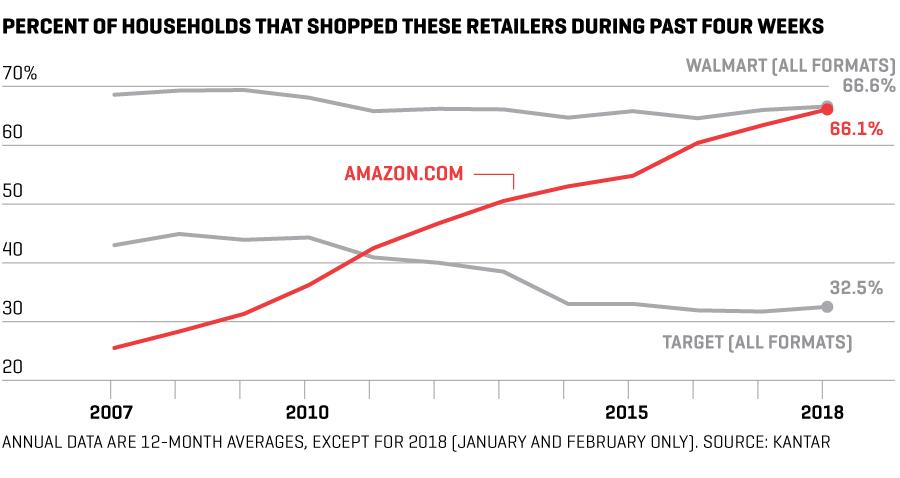
年度數(shù)據(jù)是12個月均值,,除了2018年(僅1月和2月數(shù)據(jù))。數(shù)據(jù)來源:凱度(Kantar)
|
最初亞馬遜賣的是書,,而書跟食品完全不同,。書不會腐壞,便于運輸和處置,?!段迨然摇罚‵ifty Shades of Grey)是亞馬遜網(wǎng)站史上最多書評的暢銷書之一,而對讀者來說,,是到當?shù)貢赀€是去巴諾書店(Barnes & Noble),,或者去亞馬遜網(wǎng)站Amazon.com買這本書,都沒有什么區(qū)別,。瑞信(Credit Suisse)分析師斯蒂芬·朱將書稱之為“性質單一,,便于處置”的產(chǎn)品,,而在這個領域亞馬遜已經(jīng)勝出。如果某商品可以用紙箱運輸,,而購買者又不大關心商品來源,,那它就是最適合亞馬遜售賣的商品。 2000年中旬,,亞馬遜開始銷售那些不易損壞的食品,,比如罐裝食品、餅干和曲奇,,在這方面亞馬遜完全勝任,。曾在亞馬遜工作了15年的伊恩·克拉克森說:“遞送一箱Cheerios保健麥圈和一本書沒多大區(qū)別,亞馬遜不需要大動筋骨改造或者新建基礎設施,?!? 生鮮食品則性質各異,處置起來困難得多,。比如香蕉很容易碰壞,,沒有兩只香蕉是一模一樣的,在供應鏈的流程里,,香蕉也在起著變化,,從青澀不熟到成熟醇美,再到熟透成糊,。 2007年,,亞馬遜還是決意嘗試生鮮食品配送??蛻粲羞@個需求,,而亞馬遜很希望用高頻率的生鮮食品訂單來撬動高利潤的非食品銷售。亞馬遜在西雅圖率先發(fā)起了AmazonFresh項目,,客戶只需網(wǎng)上下單,,鮮食就會遞送到家。 然而亞馬遜的網(wǎng)站并不適合人們購買食物,。多數(shù)的電商交易是購買2到4件商品,,買家一般定向搜索購買,。而在生鮮食品店,,購物者一般會左看右看,一個訂單平均下來可能有50件商品,。AmazonFresh的第一位全職員工克拉克森分析說:“我到今天還是這么認為——亞馬遜的業(yè)務就是單件購物,,客戶買了需要的東西就干別的事去了。人們不會在亞馬遜上買這買那來把冰箱塞滿的,?!痹谏r食品店,,購物者這周和下周購買的商品中,有85%是一樣的,,所以知道購物者近期買了什么就能判斷他將來會買什么,。買書就是另一回事了,買一本《五十度灰》就足夠了,。 為了適應消費者對食品的不同購買方式,,亞馬遜嘗試為AmazonFresh設計了一個獨立網(wǎng)站。建這個獨立網(wǎng)站還有另一個原因:鮮食的保質期短,,亞馬遜必須一個城市接另一個城市地鋪開它的服務,,而這并不是亞馬遜的常規(guī)策略。亞馬遜不能夠把鮮食產(chǎn)品鋪貨到全國的網(wǎng)絡,,然后向全美推出網(wǎng)購服務,。“傳統(tǒng)的亞馬遜品類產(chǎn)品就是這么干的,,也贏得了市場,。那么多人涌到網(wǎng)上購買,這個不適合生鮮食品類,?!笨死松f。 |
Books, where it all started for Amazon, are the anti-food. They never spoil and are simple to ship and handle. Fifty Shades of Grey, one of the site’s bestselling and most reviewed books of all time, is the same whether you buy it at your local independent store, at Barnes & Noble, or on Amazon.com. Books are what Credit Suisse analyst Stephen Ju calls “homogeneous, easy-to-handle” products, and Amazon has excelled at selling things that fit this criteria. If it can be shipped in a box and the purchaser cares little about whom she’s buying it from, it’s the perfect product for Amazon to sell. Nonperishable groceries like canned goods, crackers, and cookies, which the company launched in the mid-2000s, were an obvious fit. “A box of Cheerios and a book aren’t that different,” says Ian Clarkson, who spent 15 years at Amazon. “You don’t have to fundamentally rewrite or build an entirely new infrastructure.” Fresh goods, however, are about as heterogeneous and challenging to handle as it gets. Bananas bruise easily, no two are the same, and they are constantly evolving within the supply chain, going from green to ripe to mush. In 2007, Amazon decided to try fresh delivery anyway. Customers were asking for it, and Amazon was intrigued by how it might be able to leverage the frequency of grocery ordering to sell higher--margin nonfood products. The company launched AmazonFresh with a pilot in ?Seattle in which users would place an order online, and the food would be delivered to their doorstep. Amazon’s website, however, was not well suited for how people shop for food. Most e-commerce transactions comprise two to four items, which buyers find through targeted search. But shoppers tend to browse grocery, and an order can average 50 goods. “Amazon’s business, I’d argue even today, is around a unit of one,” explains Clarkson, who was AmazonFresh’s first full-time employee. “You buy it and move on. People don’t shop to fill their fridge that way.” And in grocery, where about 85% of the items people purchase are the same week to week, what customers bought recently is highly relevant to what they’ll buy again. That’s not the case for books. One copy of Fifty Shades is enough. To cater to this different way of shopping, Amazon tried designing a separate website for AmazonFresh. The stand-alone site was necessary for another reason as well: Fresh food’s short shelf life required Amazon to roll out the service city-by-city—then an unusual launch strategy for the company. Amazon couldn’t just put products into a national fulfillment network and then turn on the web experience for the entire U.S. “That’s how traditional Amazon categories get an advantage,” says Clarkson. “You have so many people coming to the site. That doesn’t work for grocery.” |
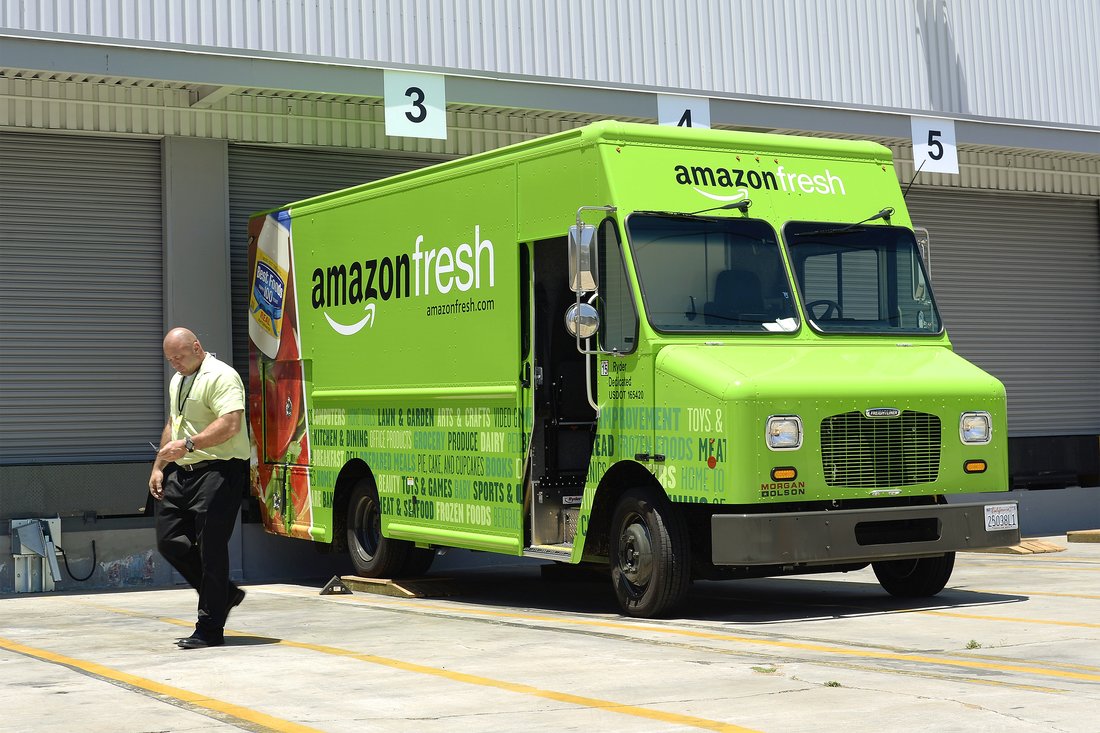
|
在西雅圖運營了6年后,,AmazonFresh擴展到了加州,但它在全美的業(yè)務覆蓋從未超過20個州,。運營的效果喜憂參半,,晨星(Morningstar)分析師R.J.霍托威說,“喜憂參半算是往好里說了,。遞送費用太貴,,交貨時間也不合適,消費者搞不明白他們下了單的食品來自哪里,?!?1月,亞馬遜宣布在部分區(qū)域停止這項業(yè)務,,但同時辯解這一舉動與收購全食超市無關,。 或許關鍵在于,AmazonFresh的規(guī)模始終不夠大,,使得服務上不了臺階,。貝恩咨詢(Bain’s Americas)零售板塊負責人亞倫·切里斯分析說:“好草莓和壞草莓的主要區(qū)別不在于采購來源,而在于誰能賣得更快,。AmazonFresh并沒有做到這一點,?!? 亞馬遜熱衷于創(chuàng)建新生意,而不是收購已有的生意,。但在嘗試自營生鮮食品業(yè)務10年后,,該考慮收購了。從開始探尋收購的可能性,,到兩年后收購全食超市,,用切里斯的話說,“兩年里亞馬遜走進美國每一家生鮮食品店,,試圖讓它們成為亞馬遜的鮮食供貨商,。” 2017年4月,,亞馬遜接到全食超市的一位咨詢師打來的電話,,他說他看到一份報道,講亞馬遜試圖收購鮮食供應鏈,,那么見面談一談,,有興趣嗎? 首次會面時,,全食超市正在經(jīng)歷著動蕩不安,。天然和有機食品這一品類本質上是由全食建立的,但當時的市場競爭非常激烈,,“全食支票”(Whole Paycheck)的聲譽也搖搖欲墜,。面對銷售增速的放緩和萎靡的股價,全食只能做個局中人了,。幾周前,,激進投資人Jana Partners公司透露了其在全食8.8%的股權。除了亞馬遜,,還有四家私募公司,,甚至據(jù)報艾伯森超市(Albertsons)也對這筆交易感興趣。 這一牽手為兩家公司都解決了許多問題,。對全食超市來說,,亞馬遜幫它從短期季度銷售壓力和做好長期業(yè)務的無限苦惱的循環(huán)中解脫出來。對亞馬遜來說,,收購全食迅即擴大了它的規(guī)模,,并滿足了它一直缺少的鮮食板塊業(yè)務需求。物流角度看,,兩家公司有固定的成本,,通過增量業(yè)務可以獲取利潤,。有了全食超市穩(wěn)定的業(yè)務量,,亞馬遜就可以構建生鮮食品業(yè)的基礎設施,。 除了規(guī)模增長,亞馬遜也獲得了更多可信度,。消費者在亞馬遜網(wǎng)站上購買的產(chǎn)品大多是品牌商品——索尼電視,、熱輪模型車、S’well牌保溫杯,,而生鮮食品大多沒有品牌,,或者有也不為人知,除了少數(shù)的幾樣(比如博特農莊胡蘿卜和克萊門氏小柑橘),。相比之下,,人們信任哪家零售商,就會去它那兒購買西蘭花和西紅柿,。鮮食領域的這種客戶信任度,,亞馬遜是沒有的,全食彌補了這一缺點,,它還給亞馬遜網(wǎng)站的購物者講述了種種關于食物起源的動人故事,。Yummy.com(基于洛杉磯的線上線下生鮮食品店)的聯(lián)合創(chuàng)始人和CEO巴納比·蒙哥馬利說:“在線購買食品生鮮,是個新概念,。我不知道這個概念哪里來的,,沒見到過,也不太明白,。這是件難事,。”或許有線下實體店,,可以讓線上購買生鮮更易于讓人接受,。 |
After six years in Seattle, AmazonFresh expanded to California but never grew its U.S. service beyond 20 states. The results have been mixed, and “that’s putting it kindly,” says Morningstar analyst R.J. Hottovy. The service was too expensive, the delivery windows were inconvenient, and people didn’t really understand where their food was being sourced from, he says. In November, Amazon said that it was cutting service in several zip codes, a move it contended was unrelated to the Whole Foods deal. And perhaps most critically, AmazonFresh hasn’t been able to reach the scale it needs to get the service to work. The big difference between good and bad strawberries isn’t where they’re sourced from, explains Aaron Cheris, who leads Bain’s Americas retail practice; it’s who’s able to sell them faster. He says, “AmazonFresh was never able to achieve that by itself.” Amazon is partial to building businesses rather buying them. But after a decade of trying to grow its grocery operation on its own, it was time for the latter. The company started exploring the possibility of an acquisition, and spent the two years leading up to the Whole Foods deal “walking around to every grocer in the U.S. asking them to be its fresh supplier,” says Bain’s Cheris. Then, in April 2017, Amazon got a call from a consultant working on behalf of Whole Foods. The grocer had seen a report that Amazon may have been interested in buying the chain in the past. Would there be any appeal in setting up a meeting? That first rendezvous came during a tumultuous period for Whole Foods. Competition was fierce in natural and organics, the very category it had essentially created, and the grocer was struggling to shake its “Whole Paycheck” reputation. Facing slowing sales growth and a flagging share price, Whole Foods was now clearly in play. Just weeks earlier, activist investor Jana Partners disclosed an 8.8% stake in the company. In addition to Amazon, four private equity firms and reportedly supermarket chain Albertsons were among those who had expressed interest in a potential deal. The tie-up solved a lot of problems for both parties. For Whole Foods, Amazon offered freedom from the relentless cycle of short-term quarterly pressures as it tried to fix the business. For Amazon, Whole Foods gave the company instant scale and the built-in demand it had lacked in fresh food. In a logistics operation, companies have a set of fixed costs and become more profitable by layering on incremental business. Thanks to Whole Foods, Amazon now had guaranteed and predictable volume for its grocery infrastructure. Along with scale, Amazon was buying credibility. Most of the products consumers buy on Amazon are branded—a Sony TV, a Hot Wheels car, a S’well water bottle. But with the exception of a few products, such as Bolthouse Farms carrots or Cuties clementines, fresh goods don’t have brands, or at least not ones that the consumer knows. Instead, we decide where to buy our broccoli and tomatoes based on our trust in the retailer. That authority was something Amazon just didn’t have in fresh. Whole Foods supplied it—as well as providing Amazon shoppers with a more appealing story about where their food originated. “The idea of ordering groceries online is conceptual,” says Barnaby Montgomery, cofounder and CEO of Yummy.com, a Los Angeles–based online grocer with brick-and-mortar stores. “I don’t know where it comes from. I don’t see it. I don’t get it. It’s a barrier.” Having a physical place to shop turns “the conceptual offer into something more tangible.” |
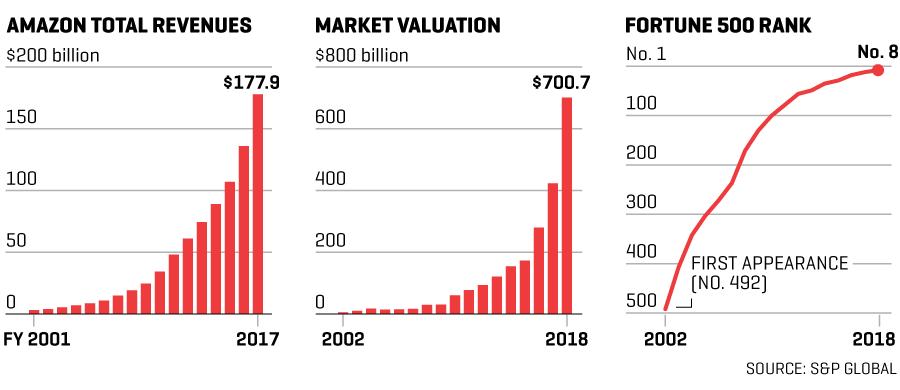
|
一個尚未解決的問題是亞馬遜將如何利用全食超市的483家實體店,來克服業(yè)界都覺得棘手的“最后一公里”難題——從倉儲中心到消費者手中,,是物流環(huán)節(jié)最后也是最昂貴的一步,。有些人認為,亞馬遜可以把實體店作為小型分銷中心,,雇人從貨架上按訂單取下產(chǎn)品,,然后派送。但Marketplace Pulse(電商智能公司)的CEO和創(chuàng)始人尤奧扎斯·卡滋尤克納斯表示,,“這么做,,理論上可行,但實踐起來就難得多,。倉庫式的倉儲跟零售倉儲是完全兩回事,。”生鮮食品店一般會最大化利用空間,,讓購物者有足夠空間走動,,購買更多商品,。而在倉庫,各類商品緊密堆放,,占據(jù)更大空間也更高效,。對生鮮食品來說,倉庫式倉儲也更合適,,因為過手太多影響質量,。艾睿鉑咨詢(AlixPartners)的馬修·哈默里認為,“生鮮食品每當被觸碰一次,,質量就下降一檔,。” 亞馬遜目前正在多方嘗試,。當我用AmazonFresh在紐約下單,,食品從新澤西的倉庫發(fā)出,由承包商用卡車運輸,。同樣食品用承諾兩小時送達的Prime Now下單,,食品從曼哈頓市中心的分銷部發(fā)出,由亞馬遜Flex司機(類似Uber模式,,公司支付駕駛員每小時18到25美元)送達,。在其他10個區(qū)域,Prime Now直接從全食超市取貨,。在小城市這個模式或許是敲門磚,,等到達一定規(guī)模亞馬遜就可以建立專門的倉庫。生鮮食品業(yè)咨詢師尼爾·斯特恩說,,“要上規(guī)模才行,。從實體店取貨派送,盡管挺蹩腳的,,但可以建立規(guī)模和客戶群,。” 未來的解決之道或許是一種混合方式:大的實體店專辟空間用于網(wǎng)上訂單食品配送,,或者實體店里包裝食物選購流程自動化,,但客戶仍可自行選擇生鮮食品。 亞馬遜消費品和AmazonFresh的前任副總裁,、現(xiàn)任某風投公司CEO的湯姆-弗菲說:“亞馬遜必將瘋狂實驗,。如果現(xiàn)在一切都清晰了,那倒會讓我大吃一驚,?!? 其他行業(yè)有被亞馬遜化的風險 被亞馬遜搞得天翻地覆的不只是生鮮食品業(yè)。下列5個行業(yè)也得小心了。 服裝業(yè) 摩根士丹利(Morgan Stanley)預測,,今年亞馬遜將超越沃爾瑪,,成為全美最大的服裝銷售商。亞馬遜已創(chuàng)立幾個自有服裝品牌,,并提供了服裝訂購服務。 銀行業(yè) 亞馬遜可以為千禧一代提供支票賬戶,,很可能它會和一家銀行合作以規(guī)避監(jiān)管問題,;貝恩咨詢預測在未來五年,亞馬遜將擁有7000萬個消費者賬戶,。 家具業(yè) 沙發(fā)和咖啡桌之類的產(chǎn)品,,在亞馬遜上的銷售增長迅速。虛擬現(xiàn)實技術的進步,,可幫助消費者評估其客廳擺家具的布局,,這將促進家具網(wǎng)購 門票服務 Ticketmaster等提供門票服務的公司不受消費者青睞,于是該領域就給亞馬遜留下了機會,。到今年3月,,亞馬遜一直在英國提供門票銷售業(yè)務,據(jù)報道亞馬遜已與Ticketmaster接洽合作事宜,。 快遞業(yè) 亞馬遜準備以其卓越的物流能力,,與UPS,聯(lián)邦快遞以及美國郵政署競爭,。華爾街日報(The Wall Street Journal)報道,,亞馬遜正在洛杉磯試水快遞服務,稱之為亞馬遜快遞(Shipping With Amazon),。 運營超市的平均利潤率只有1%,,生鮮食品業(yè)的狀況怎么說都是慘淡的。為什么亞馬遜會成為威脅,,因為這套數(shù)學算法不適用于它,。投資者們已經(jīng)認可貝佐斯對短期利潤的忽視。Peapod聯(lián)合創(chuàng)始人托馬斯·帕金森在去年的一個食品行業(yè)會議上說,,“我們第一次碰到這樣的競爭對手,,亞馬遜就是其中一個,他們不關心賺錢的事,,這對我們是個挑戰(zhàn),。”食品企業(yè)家格雷格·施泰爾騰波爾則認為,,“亞馬遜們所帶來的破壞性,,不在于他們有解決方案,而是他們不按這套游戲規(guī)則出牌?!? 食品配送,,是對傳統(tǒng)業(yè)務模式的一種怪異的回歸。20世紀初,,超市興起取代了百貨店,。那時候去百貨店,柜臺后的柜員會幫顧客從貨架上抽取產(chǎn)品,,而新型的超市模式,,則要求顧客推著購物車自行取貨,以換取較低的商品價格?,F(xiàn)如今,,食品配送業(yè)務的發(fā)展,不但回歸到讓別人幫你從貨架取貨那種老模式,,還更進一步送貨上門——高盛(Goldman Sachs)預測零售商為這項服務需支出每單22.68美元,。大多數(shù)消費者都不愿為配送付錢,。福雷斯特調研公司(Forrester)的分析師布倫丹·維切爾指出,,“人們有一種信仰,就是不愿意為快遞付費,?!? 盡管如此,生鮮食品業(yè)的主管們還是意識到了市場的走勢,。一份高盛的預測認為,,到2027年生鮮食品業(yè)20%的銷售將在網(wǎng)上進行。這一市場份額就是亞馬遜的著眼點——但連鎖超市也不能丟了這塊市場,。要下的賭注高地驚人,。沃爾瑪在2月公布其電商銷售業(yè)務增長放緩后,它的股價創(chuàng)下了三十年內單日最大跌幅,。沃爾瑪利用其實體店,讓顧客線上下單,,到店取貨,而在上市公司財報會議上,,沃爾瑪說會“加速”食品配送業(yè)務,。(沃爾瑪一位發(fā)言人指出,,第四季度電商業(yè)務增長下滑基本是規(guī)劃好的,因為公司已完成全年指標,。) |
One question that remains unanswered is how Amazon will use Whole Foods’ 483 physical stores to help solve what’s known in the industry as the “l(fā)ast mile” problem—the final and most expensive step of the delivery process that takes a product from a central hub to its final destination. There’s some speculation that Amazon could use the stores as mini distribution centers, hiring people to pick product off the shelf to fulfill online orders that would then be sent out for delivery. “It makes sense in theory, but it’s a much harder problem than it appears,” says Juozas Kaziukenas, CEO and founder of e-commerce intelligence firm Marketplace Pulse. “The way you stock for the warehouse and retail are two different things.” Grocery stores are maximized to make customers wander through and buy more stuff. Warehouses, where random products are stacked next to each other to make the most of the space, are much more efficient. They’re also better for fresh goods because increased handling hurts quality. “Every time you touch a fresh product it degrades it,” says Matthew Hamory of consultancy AlixPartners. Right now, Amazon seems to be trying it all. When I placed an order via AmazonFresh in New York City, the food came from a New Jersey warehouse and was delivered off a truck by a contractor. When I did the same with Prime Now, which offers delivery in two hours, the goods came from a distribution facility in Midtown Manhattan and were dropped off by an Amazon Flex driver—an Uber-type model in which the company pays drivers $18 to $25 an hour. In 10 other markets, Amazon is offering Prime Now delivery directly from Whole Foods stores. That model could be a good stepping-stone in smaller cities until the company reaches enough volume to build out a dedicated warehouse. “You have to scale your way up there,” says grocery consultant Neil Stern. “Picking from a store, while crappy, is a way to establish volume and a customer base.” The future may be a hybrid approach: bigger stores that have a space carved out for putting together online deliveries. Or a store where the selection of packaged goods is automated but customers can pick out their own fresh goods. “They’re going to experiment like crazy,” says Tom Furphy, formerly a VP of consumables and AmazonFresh and now CEO of a venture capital firm. “I would be completely surprised if they have it all figured out by now.” OTHER INDUSTRIES AT RISK OF GETTING AMAZONED Grocery isn’t the only business Amazon is turning upside down. Here are five sectors that have had better watch their backs Apparel Morgan Stanley estimates that Amazon will surpass Walmart to become the biggest seller of apparel in the U.S. this year. The company has launched several private labels and a clothing subscription service. Banking Amazon could offer checking accounts aimed at millennials. It’s likely that it would partner with a bank to avoid regulatory issues; Bain estimates it could have more than 70 million consumer relationships over the next five years. Furniture Products like sofas and coffee tables are one of the fastest-growing categories at Amazon. Advancements in virtual reality that help shoppers visualize the layout of their living rooms will help push purchases online. Event Tickets With the likes of Ticketmaster getting little consumer love, this is an area ripe for disruption. Until March Amazon ran a ticketing business in the U.K., and it has reportedly had conversations with Ticketmaster about a partnership. Delivery Amazon is planning on using its logistics prowess to compete with UPS, FedEx, and USPS. The Wall Street Journal has reported that the company is testing a delivery service in Los Angeles called Shipping With Amazon. With the average supermarket operating on a 1% profit margin, the economics of the grocery industry are fragile at best. What makes Amazon such a threat is that the same math just does not apply. Investors have accepted that Bezos is uninterested in short-term profitability. “They are one of our first competitors who doesn’t really care about making money,” Peapod cofounder Thomas Parkinson said at a food conference last year, “so that’s a challenge for us.” Food entrepreneur Greg Steltenpohl puts it this way: “They’re not disruptive because they have all the answers, but because they don’t have to play by the same rules.” Food delivery is a strange reversion to an old way of doing business. The supermarket was invented in the early 20th century to replace the full-service store of the past, where a clerk behind the counter would pull products off the shelves for the customer. The new supermarket model required shoppers to push the carts and do the heavy lifting themselves in exchange for lower prices. Today, a growing segment not only wants some version of that old-timey archetype in which someone else collects the items for them, they also want them delivered to their homes—services that Goldman Sachs estimates cost a retailer $22.68 per order. That’s just not something most consumers are willing to cough up. “There’s a cultlike avoidance of paying for delivery,” explains analyst Brendan Witcher of research firm Forrester. Despite the cost, grocery executives realize that’s where the market is heading. One Goldman estimate puts 20% of the industry online by 2027. That’s market share Amazon has in its sights—and that supermarket chains cannot afford to lose. The stakes are incredibly high. When Walmart reported in February that its e-commerce sales growth had slowed, the stock took its biggest one-day dive in three decades. Walmart has been leveraging its physical locations with click-and-collect, in which customers order online and pick up their groceries at the store, but during the earnings call the company said it would “accelerate” grocery delivery. (A Walmart spokesman said the lower fourth-quarter e commerce rate was largely planned, as the company met its full-year guidance.) |
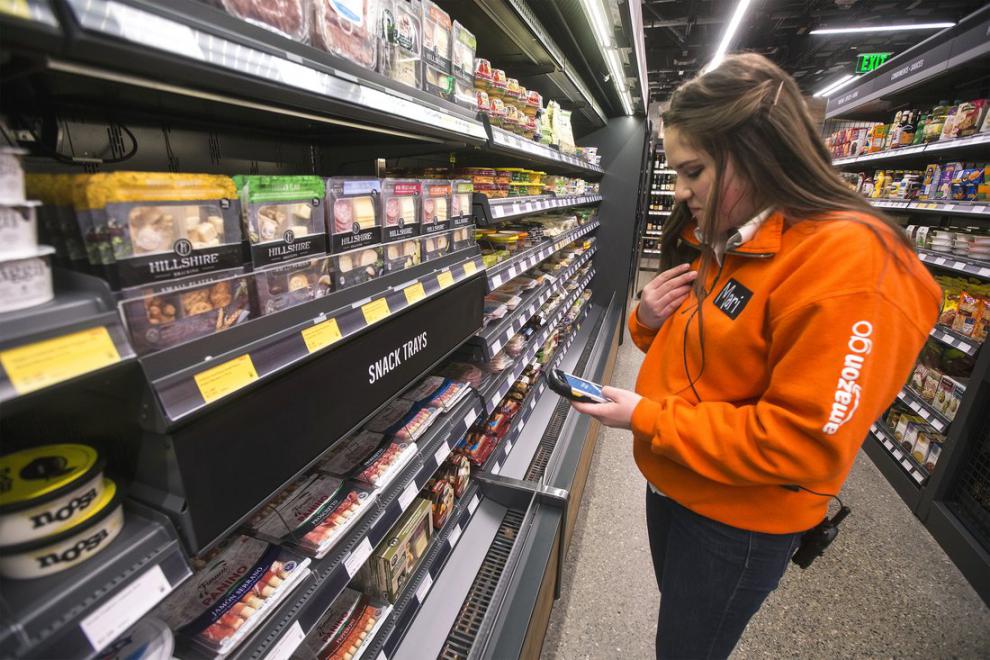
|
在這場生鮮食品業(yè)的商戰(zhàn)中,,沃爾瑪?shù)慕K極武器是門店多,,而亞馬遜的拳頭是Prime。4月,,亞馬遜宣布其付費會員已超過1000萬,,而且它將提高會員年費。晨星的霍托威認為,,新增會員數(shù)趨于平緩,,亞馬遜現(xiàn)在注重的是讓現(xiàn)有會員增加支出,,而不是新增會員,。 收購全食超市就是明證。1010data的數(shù)據(jù)顯示,,在收購當時,,81%的全食超市客戶同時也是亞馬遜客戶。將全食超市納入麾下,,與其說是獲取了新客戶群,,不如說是利用全食讓亞馬遜客戶進一步依賴其生態(tài)系統(tǒng)——將全食著名的365品牌放到網(wǎng)上,在全食超市售賣亞馬遜音箱(Echo)等產(chǎn)品,,在全食超市設立亞馬遜儲物柜,,便于客戶取貨。這種共生互利已初見成效,,收購完成后,,到訪帶有亞馬遜儲物柜的全食超市的顧客數(shù)增加了11%。 貝佐斯說,,他的目標是要讓Prime變得不可或缺,,以至于不成為Prime會員就是“不負責任”。亞馬遜不能沒有Prime,,據(jù)預測,,Prime會員每年在亞馬遜平均消費1500美元,比非會員每年消費額的兩倍還多,。艾睿鉑咨詢的哈默里解釋:“一旦你成為Prime會員,,就不需要去其他地方購物?!睋?jù)知情人透露,,亞馬遜的目標是成為所有搜索的起點,。曾任谷歌(Google)CEO的埃里克-施密特說,“很多人以為我們的對手是必應(Bing)或雅虎(Yahoo),,但實際上,,我們最大的對手是亞馬遜?!? 控制了搜索就意味著掌握了數(shù)據(jù),。亞馬遜掌握了你尋找的每一個產(chǎn)品,你選擇的每一個品類,,你放入購物車又刪掉的每一件商品——這就是所謂“點擊流量”?,F(xiàn)在亞馬遜又推出了現(xiàn)實版的點擊流量——Amazon Go無人便利店。這家位于西雅圖的無人店使用高架攝像頭和貨架內的重量傳感器來追蹤購物行為,,消費者拿完商品直接走人,,甚至不需要結帳。 亞馬遜對全食超市也有類似的安排嗎,?或許安排在低價的365門店,,但專家們懷疑這種“拿了就走”的模式是否標志著行業(yè)前沿。全食超市的一項重要資產(chǎn)是高品位——客戶的感官,、視覺感受和購物體驗俱佳,。這是一個重要的賣點,在這個時代,,平庸寡淡的零售店已經(jīng)倒閉或正在倒閉,。 在貝佐斯一直期望創(chuàng)建的包羅萬象且流暢無比的零售體驗中,門店是其中一環(huán),,而亞馬遜的虛擬助手Alexa以及Echo音箱則是另一環(huán),。維切爾認為,“未來購買生鮮食品就是動動嘴——送些食品來,,加點大蒜,,不要西紅柿。亞馬遜正在一步步地實現(xiàn)這一切,?!奔幽么蠡始屹Y本市場(RBC Capital Markets)預測,到了2020年,,有1280萬戶家庭會使用Alexa, 他們在亞馬遜上的消費會增長10%,。 “一朝成為Prime會員,無慮其他” 艾睿鉑咨詢馬修·哈默里 亞馬遜還有一記絕殺,,紐約大學的加洛韋稱之為“零點擊環(huán)境”,,在這一環(huán)境下的重復購買行為——大部分零售是重復購物——不是結束在門階,而是結束在你的櫥柜或者冰箱,。部分地區(qū)的Prime會員使用包含監(jiān)控探頭,、智能鎖和一個手機app的亞馬遜鑰匙系統(tǒng)(Amazon Key),,就能讓包裹遞送進家門。亞馬遜在4月收購了智能門鈴公司Ring,,讓加洛韋的預言更近成真,。他說:“很難想象有了這些的亞馬遜會干出什么?!? 無論你認為這聽起來有點烏托邦或者是反烏托邦,,那只是因為視角不同。但亞馬遜也有不小的風險,,因為人們最終會覺得這家公司知道太多關于我們的信息,,或者操控了太多我們的生活,亞馬遜帶來的所有便利結果反而讓人們不舒服,。不信問問馬克·扎克伯格吧,,他剛剛因為Facebook的隱私泄露和安全問題去國會山作證了。 食品業(yè)務可能成為亞馬遜的轉折點之一,。過去幾年里,,隨著人工智能和機器學習的興起,科技世界大步前進,,而食品行業(yè)卻反其道而行之,,走向農業(yè)的非產(chǎn)業(yè)化,。在加州大學伯克利分校領導食品風險實驗室項目的威廉·羅森茨威格認為:“追求健康和可持續(xù)的食品行業(yè)與亞馬遜模式是不協(xié)調的,。我擔心亞馬遜的文化里沒有食品的基因。便捷,、低價和快速——這些不是食品行業(yè)的價值觀和核心競爭力,。” 在便捷性與更多關注客戶之間亞馬遜該如何取舍,?這個問題恐怕Alexa也還沒有答案,。(財富中文網(wǎng)) 譯者:Hank |
Walmart’s ultimate weapon in the grocery wars is its massive store footprint; Amazon’s is Prime. In April, Amazon announced that the membership service had exceeded a whopping 100 million paid subscribers and that it would increase its annual fee. Morningstar’s Hottovy thinks that the market for new members may be plateauing, and that Amazon is now focused on increasing what current Prime users spend rather than recruiting new ones. The Whole Foods deal was a case in point. According to 1010data, at the time of the acquisition, 81% of Whole Foods customers were already Amazon shoppers. So rather than capturing a new base, adding Whole Foods to the portfolio served as a tool to further ingrain Amazon customers within its ecosystem—offering Whole Foods’ popular 365 private label online, selling products like the Amazon Echo in its stores, and setting up Amazon lockers within Whole Foods for customers to pick up packages. Already, the symbiosis is at work. Since the deal closed, quick visits to Whole Foods were up 11% in stores with Amazon lockers. Bezos says his aim is to make Prime so essential that it’s “irresponsible” not to join. And its value to the company is unmissable: By some estimates, Prime members spend an average $1,500 a year on Amazon, more than twice as much as non-Prime users. “Once you’re a Prime customer, you don’t go anywhere else to look,” explains AlixPartners’ Hamory. The goal, say insiders, is for Amazon to be the place where you start all of your searches. “Many people think our main competition is Bing or Yahoo,” Google’s onetime CEO Eric Schmidt has said. “But, really, our biggest search competitor is Amazon.” Capturing search means capturing data. Amazon knows every product you look for, every category you choose, everything you put in your cart then abandon—what’s known as the “clickstream.” Now the company is trying to capture the real-life version of the clickstream with Amazon Go. The Seattle store uses overhead cameras and weight sensors in shelves to track shoppers so closely that they can simply leave the store when done shopping—no need to check out. Might Amazon have something similar planned for Whole Foods stores? Perhaps in its lower-priced 365 locations, but experts are skeptical that the “just walk out” experience is coming to flagship outposts. One of Whole Foods’ assets is that it is high-touch—sensory, visual, and experiential. That’s a major selling point in an era where boring, mediocre retail is dead or dying. The stores play one part in the all-encompassing, frictionless retail experience that Bezos has long aspired to create; Alexa, Amazon’s virtual assistant, and its Echo speaker devices play another. “The future of grocery shopping is most likely the ability to say, send me groceries, add garlic, remove tomatoes,” says Witcher. “Amazon has put the pieces in place to actually make it happen.” RBC Capital Markets predicts that by 2020, 128 million households will be using Alexa, driving a 10% increase in their Amazon spending. “Once you’re a Prime customer, you don’t go anywhere else.” Mathew Hamory of consultancy AlixPartners Another aspect of Amazon’s end-game is what NYU’s Galloway calls a “zero-click environment” in which recurring purchases—the majority of retail—end up not just on your doorstep but in your closet or fridge. Prime members in some locations can already get packages delivered inside their homes with Amazon Key, which includes a security camera, smart lock, and app. Amazon’s April acquisition of smart doorbell company Ring makes Galloway’s vision even more likely. “It’s staggering to think about what they could do with that,” he says. Whether this sounds utopian or dystopian is a matter of perspective. But there is no small risk to Amazon that people eventually begin to feel like the company knows too much or controls too much of their lives, that they become uncomfortable with the consequences of all of this convenience. Just ask Mark Zuckerberg, who recently testified on Capitol Hill over Facebook’s privacy and security issues. Food could be part of that tipping point for Amazon. For the past few years, as the tech world has been making strides with artificial intelligence and machine learning, foodies have been moving in the opposite direction, pushing to deindustrialize the agricultural system. “Healthy and sustainable food is incoherent with the Amazon model,” says William Rosenzweig, who leads the Food Venture Lab program at UC–Berkeley. “I worry that the culture of Amazon doesn’t contain that gene set. Convenience, price, and speed—those are not the right values or core competencies of food.” Can Amazon learn to walk that delicate line between convenience and care? That’s something that not even Alexa can answer yet. |
